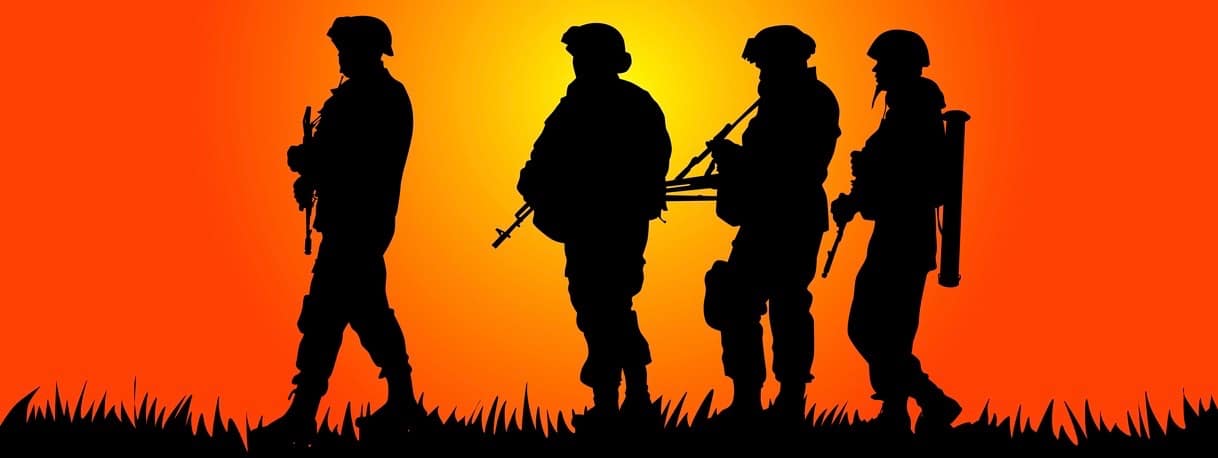Night parachute jumps are a great test because they are a jump into the unknown. At the beginning, a night parachute jump looks like a subway car stuffed with people wearing 200 lbs. of parachutes, overstuffed rucksacks, weapons inside 4-foot padded duffel bags and, always, lots of sweat. As the drop zone approaches, the few white lights go out, people wake up, put on their helmets, and the red lights come on bathing the entire scene in a lukewarm glow. Minutes before the drop, the ramp on the plane goes down, and a pitch-black hole of wind, noise, cold, and unknown replaces the comforting grey and green of the plane interior.
One minute before the drop, the entire plane of soldiers is facing the howling wind roaring from the black, open exit. Soldiers have their yellow static lines hooked into the long, thick cables running down the plane’s interior, and everyone is desperately trying to remain upright as the plane bounces down the last few miles to the drop zone. The jumpmaster looks out the ramp one last time, watches as the red jump light turns green, yells “Follow Me!” and walks off the ramp followed by the rest of the parachutist and disappears into the howling blackness.
In a night parachute jump, you cannot see the ground, you cannot see if you are over water, and you cannot see if you are dropping into tall trees or a nice open field. The Special Forces do a lot of night parachute jumps over land and sea. Special Forces soldiers develop well-seasoned skills in resiliency to be equally prepared and unsurprised when the planned operations diverge quickly into the unknown.
There are a lot of takeaways for CEOs and business leaders from Special Forces operations—especially in this unprecedented time of uncertainty. Here’s what leaders can apply today:
Know the direction of true north—your organization’s purpose
When you land at night, the first thing that you do is place your weapon into action, secure your equipment, and then open your compass to find North. Knowing your sense of direction is the next critical step to move to a specified assembly area. The assembly area is where soldiers meet, re-organize, and quickly move out to their objective. The use of a compass to find North to ensure your direction is the equivalent of purpose for people and organizations. In unknown situations, the conditions have changed, resources have changed, but purpose and direction remain unchanged. Always ensure that everyone knows the direction and purpose you are moving towards.
Always remember people accomplish every mission
The US Army has a motto, “Mission First, Soldiers Always.” This motto holds together two incompatible elements: a focus on the mission and a focus on people. “Mission First, Soldiers Always” clearly recognizes the importance of mission accomplishment with the importance that, without people, the mission will not be accomplished. Too often, when events, conditions, and resources begin to overwhelm us, we start to take people for granted. People are always the way to accomplish any mission especially when times are at their most difficult.
Over-communicate purpose & success
In the final minutes in the airplane before a parachute drop, the Jumpmaster, the Parachutist-In-Charge, gives a series of jump readiness commands that are highly standardized employing both motion commands and voice commands. Everywhere in the Army where parachute operations occur, Jumpmasters use the same motion and voice commands all the time and every time. This dual use of motion commands with voice commands is because communication during the final moments before jumping from the airplane are vitally important for safety and mission success. The Jumpmaster’s commands seek to over communicate and to continually communicate during a very stressful time. The use of over-communication and continuous communication reduces stress in soldiers.
Do the best you can in the next 5 minutes
When situations become so difficult, success can be found breaking time into very small pieces so you worry only about your immediate success, what you can control, and not what is out of your control. In stressful and unknown situations, focus on the next 5 minutes and no longer. In the unknown and difficult, your biggest enemy is your mind that wants to plan and to anticipate just how bad things may become. The secret in difficult and trying times is to focus solely on doing well over the next 5 minutes and only focus on those next 5 minutes no matter what.
Apply Commander’s Intent to ensure initiative
Initiative helps soldiers’ triumph over changing conditions using improvisation and experience. Commander’s Intent is the description of what success looks like at the end of the operation. Did we drive the enemy off? Did we make the road safe? Did we bring in the equipment to the village? During mission planning, all soldiers understand WHAT they are doing but they also understand WHY they are doing it. Understanding what the commander wants to achieve and what success looks like is the entire WHY of the mission. In an enterprise, this means all employees know what the CEO expects as an outcome. Employees know their plan of action, but there’s adaptability built in so that even if the mission strays from an intended path, success can be met every time using soldier’s initiative.
We must venture into the unknown to be successful. Moving into the unknown, whether we chose to or not, is always complicated, always challenging, and success is never assured. Success during unknown challenges can work when we know our direction and purpose, when we value our team, when we over communicate our purpose, when we focus on building small successes into large wins, and when we clearly describe success so our team can use their initiative. The unknown always becomes known and when we put fear aside, embrace the challenge, and believe in our team, we can find success in the most daunting conditions.








